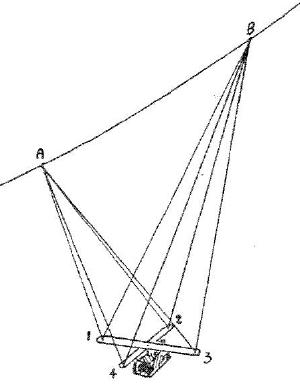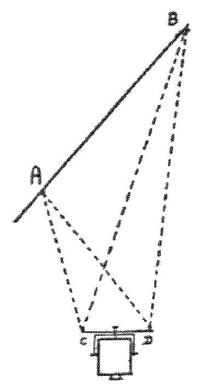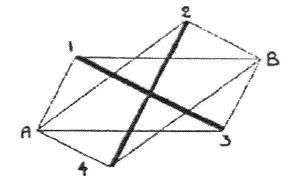
ELLIPTICAL PENDULAR SUSPENSION.
Pierre L. PICAVET - FRANCE - Nov. 1912.
The need to frame the photograph with precision leads the aerophotographer by kite to use a pendular suspension. As we know, attaching the camera directly to the tether line either by use of a wooden lath or a triangle such as used by Mr. Lecornu, can only bring disappointments because vibrations of the line are affecting it unless the shutter speed is very high which supposes a wide aperture lens and therefore an expensive lens.
Let us examine existing pendular suspensions which are giving good results. These are the ones used by Captain 5aconney.
We will dimiss the most recent one since it is too complicated to build but we will keep in mind the flexible elliptical Saconney suspension as used by Mr. Aubry. The suspension we use is derived from it.
 We attach it directly to the tether, this way of operating
requiring only one kite and one tether line.
We attach it directly to the tether, this way of operating
requiring only one kite and one tether line.
The camera support is a U shaped frame allowing the camera to pivot around its centre of gravity. Two wing-nut screws passing through the camera wall at its centre of gravity allow one to fasten the camera body in any position and to let it describe a semi-circle in the vertical plane.
This U shaped frame is attached at its centre to a cross-piece by use of another wing-nut screw thus allowing the rotation of the camera around a 360°r; radius.
This crosspiece is made of two lengths of wood, 2.5 cm X 1 cm, bearing eye-bolts at each extremity. The length of the wooden pieces is 71 centimetres. These are notched for 1/3 of their thickness so that it can be easily set in a cross manner. The sides of the square so obtained are 50 cm long, The suspension is made of one length of 1.5 mm string and 18 metres long. One end is attached to the ring A and, the cross piece being open, we successively thread the string through the rings A and B as well as the four eye-bolts in the following order: A, 1, B, 4, A, 2, B, 3, A, both ends of the string are tied to A. We then obtain the rig shown in Fig. l. It only remains then to fix A and B at two stationary points and to set the cross horizontally, this way we stop the four strands in A and B.
In this manner the supension is elliptical since the sum of the length of the two strands passing through one of the eye-bolts is always equal to one fourth of the total length of the string thus, the CD plane remains always horizontal.
 Two toggle-pins placed permanently on the tether line allow
the attachment of rings A and B. One of the advantages of this
suspension is its extreme lightness since, with its
crosspiece, it only weighs 400 grams. The pendulum being
very long (Approx. 2 metres), the lateral swinging motions
are very slow while the fore and aft swinging motions are
rapidly dampened by the friction of the string on the four
eye-bolts.
Two toggle-pins placed permanently on the tether line allow
the attachment of rings A and B. One of the advantages of this
suspension is its extreme lightness since, with its
crosspiece, it only weighs 400 grams. The pendulum being
very long (Approx. 2 metres), the lateral swinging motions
are very slow while the fore and aft swinging motions are
rapidly dampened by the friction of the string on the four
eye-bolts.
It would be more appropriate to use 4 small wheels in place of eye-bolts, but we are quite satisfied with this rudimentary apparatus. Shutter speed of 1/100th of a second are quite sufficient and therefore we may use inexpensive lenses. The cost of this suspension is itself very low.
The taking of photographs is very easy.
We hope that this suspension will attract the attention of some kite-flyers and feel certain that it will truly help them.
Pierre L. PICAVET - FRANCE - Nov. 1912.